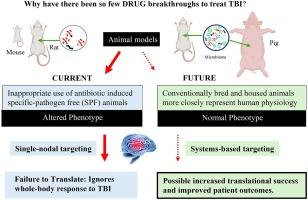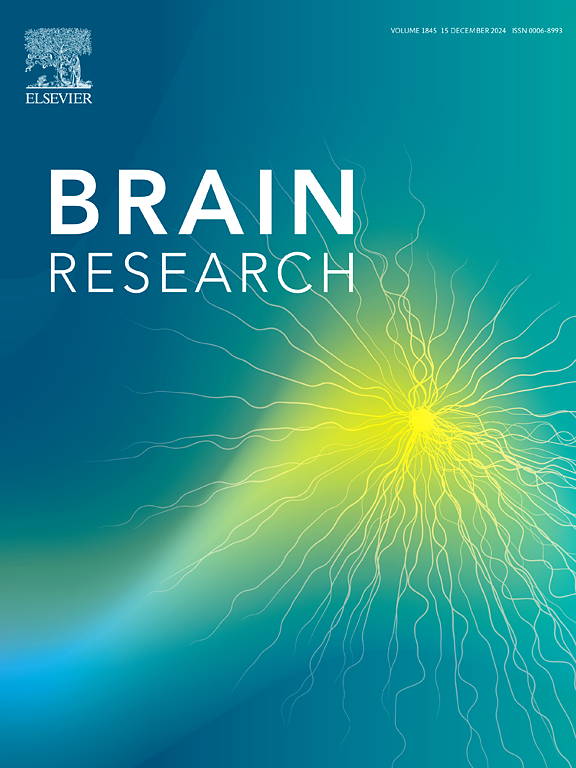Traumatic brain injury: Symptoms to systems in the 21st century
IF 2.7
4区 医学
Q3 NEUROSCIENCES
引用次数: 0
Abstract
Severe traumatic brain injury (TBI) is a devastating injury with a mortality of ∼ 25–30 %. Despite decades of high-quality research, no drug therapy has reduced mortality. Why is this so? We argue two contributing factors for the lack of effective drug therapies include the use of specific-pathogen free (SPF) animals for translational research and the flawed practice of single-nodal targeting for drug design. A revolution is required to better understand how the whole body responds to TBI, identify new markers of its progression, and discover new system-acting drugs to treat it. In this review, we present a brief history of TBI, discuss its system’s pathophysiology and propose a new research strategy for the 21st century. TBI progression develops from injury signals radiating from the primary impact, which can cause local ischemia, hemorrhage, excitotoxicity, cellular depolarization, immune dysfunction, sympathetic hyperactivity, blood-brain barrier breach, coagulopathy and whole-body dysfunction. Metabolic reprograming of immune cells drives neuroinflammation and secondary injury processes. We propose if sympathetic hyperactivity and immune cell activation can be corrected early, cardiovascular function and endothelial-glycocalyx-mitochondrial coupling can be restored, and secondary injury minimized with improved patient outcomes. The therapeutic goal is to switch the injury phenotype to a healing phenotype by restoring homeostasis and maintaining sufficient tissue O2 delivery. We have been developing a small-volume fluid therapy comprising adenosine, lidocaine and magnesium (ALM) to treat TBI and have shown that it blunts the CNS-stress response, supports cardiovascular function and reduces secondary injury. Future research will investigate its suitability for human translation.

创伤性脑损伤:从症状到系统的 21 世纪。
严重创伤性脑损伤(TBI)是一种破坏性损伤,死亡率高达 25%至 30%。尽管经过数十年的高质量研究,但没有任何药物疗法能降低死亡率。为什么会这样呢?我们认为,导致缺乏有效药物疗法的两个因素包括:在转化研究中使用无特异性病原体(SPF)的动物,以及在药物设计中采用单一结节靶向的错误做法。为了更好地了解全身对创伤性脑损伤的反应、确定其进展的新标志物以及发现治疗创伤性脑损伤的新系统作用药物,我们需要一场革命。在这篇综述中,我们将简要介绍创伤性脑损伤的历史,讨论其系统病理生理学,并提出 21 世纪的新研究战略。创伤性脑损伤的发展源于由原发性撞击辐射而来的损伤信号,这些信号可导致局部缺血、出血、兴奋性中毒、细胞去极化、免疫功能紊乱、交感神经亢进、血脑屏障破坏、凝血功能障碍和全身功能障碍。免疫细胞的代谢重编程推动了神经炎症和继发性损伤过程。我们建议,如果能及早纠正交感神经亢进和免疫细胞活化,就能恢复心血管功能和内皮-糖萼-线粒体耦合,最大限度地减少继发性损伤,改善患者预后。治疗目标是通过恢复平衡和保持足够的组织氧气输送,将损伤表型转换为愈合表型。我们一直在开发一种由腺苷、利多卡因和镁(ALM)组成的小容量液体疗法来治疗创伤性脑损伤,结果表明这种疗法能减弱中枢神经系统的应激反应、支持心血管功能并减少二次损伤。未来的研究将探讨这种疗法是否适合于人体。
本文章由计算机程序翻译,如有差异,请以英文原文为准。
求助全文
约1分钟内获得全文
求助全文
来源期刊

Brain Research
医学-神经科学
CiteScore
5.90
自引率
3.40%
发文量
268
审稿时长
47 days
期刊介绍:
An international multidisciplinary journal devoted to fundamental research in the brain sciences.
Brain Research publishes papers reporting interdisciplinary investigations of nervous system structure and function that are of general interest to the international community of neuroscientists. As is evident from the journals name, its scope is broad, ranging from cellular and molecular studies through systems neuroscience, cognition and disease. Invited reviews are also published; suggestions for and inquiries about potential reviews are welcomed.
With the appearance of the final issue of the 2011 subscription, Vol. 67/1-2 (24 June 2011), Brain Research Reviews has ceased publication as a distinct journal separate from Brain Research. Review articles accepted for Brain Research are now published in that journal.
 求助内容:
求助内容: 应助结果提醒方式:
应助结果提醒方式:


